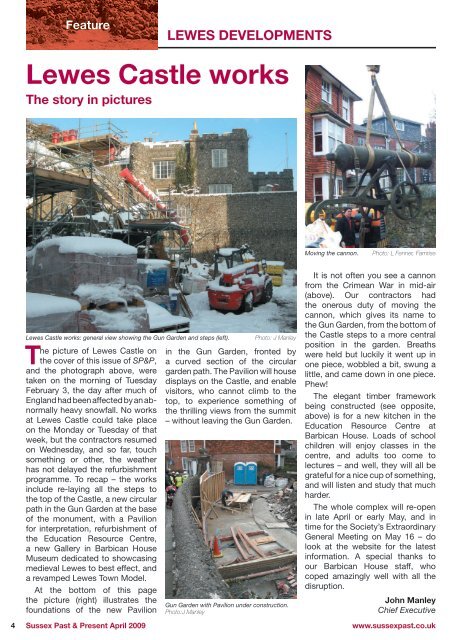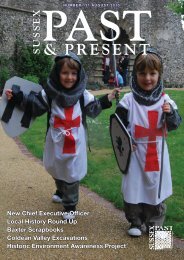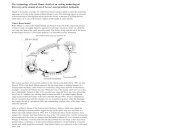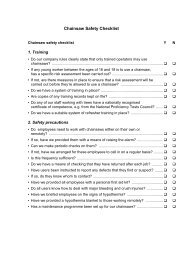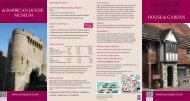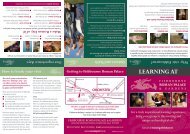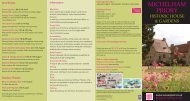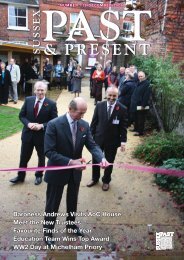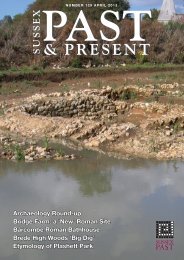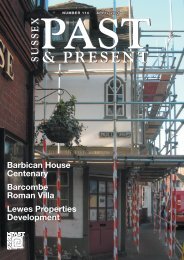NUMBER 117 APRIL 2009 - The Sussex Archaeological Society
NUMBER 117 APRIL 2009 - The Sussex Archaeological Society
NUMBER 117 APRIL 2009 - The Sussex Archaeological Society
- No tags were found...
You also want an ePaper? Increase the reach of your titles
YUMPU automatically turns print PDFs into web optimized ePapers that Google loves.
FeatureLEWES DEVELOPMENTSHISTORYResearchLewes Castle works<strong>The</strong> story in picturesLewes Castle works: general view showing the Gun Garden and steps (left).<strong>The</strong> picture of Lewes Castle onthe cover of this issue of SP&P,and the photograph above, weretaken on the morning of TuesdayFebruary 3, the day after much ofEngland had been affected by an abnormallyheavy snowfall. No worksat Lewes Castle could take placeon the Monday or Tuesday of thatweek, but the contractors resumedon Wednesday, and so far, touchsomething or other, the weatherhas not delayed the refurbishmentprogramme. To recap – the worksinclude re-laying all the steps tothe top of the Castle, a new circularpath in the Gun Garden at the baseof the monument, with a Pavilionfor interpretation, refurbishment ofthe Education Resource Centre,a new Gallery in Barbican HouseMuseum dedicated to showcasingmedieval Lewes to best effect, anda revamped Lewes Town Model.At the bottom of this pagethe picture (right) illustrates thefoundations of the new PavilionPhoto: J Manleyin the Gun Garden, fronted bya curved section of the circulargarden path. <strong>The</strong> Pavilion will housedisplays on the Castle, and enablevisitors, who cannot climb to thetop, to experience something ofthe thrilling views from the summit– without leaving the Gun Garden.Gun Garden with Pavilion under construction.Photo:J ManleyMoving the cannon.Photo: L Fenner, FarnriseIt is not often you see a cannonfrom the Crimean War in mid-air(above). Our contractors hadthe onerous duty of moving thecannon, which gives its name tothe Gun Garden, from the bottom ofthe Castle steps to a more centralposition in the garden. Breathswere held but luckily it went up inone piece, wobbled a bit, swung alittle, and came down in one piece.Phew!<strong>The</strong> elegant timber frameworkbeing constructed (see opposite,above) is for a new kitchen in theEducation Resource Centre atBarbican House. Loads of schoolchildren will enjoy classes in thecentre, and adults too come tolectures – and well, they will all begrateful for a nice cup of something,and will listen and study that muchharder.<strong>The</strong> whole complex will re-openin late April or early May, and intime for the <strong>Society</strong>’s ExtraordinaryGeneral Meeting on May 16 – dolook at the website for the latestinformation. A special thanks toour Barbican House staff, whocoped amazingly well with all thedisruption.John ManleyChief ExecutiveNew kitchen for the Education ResourceCentre.Photo: J ManleyAnne of ClevesHouseLest we forget – hopefully not ourhard-working Trustees or Anneof Cleves House. <strong>The</strong> formerinspect in the snow (see below)the refurbished tile-cladding on theEvery Wing, while as I write, Anneof Cleves House is being enhancedwith brand new rainwater goods,a state of the art alarm system,improved reception lighting – andremains open to the public!John ManleyChief ExecutiveTrustees visiting Anne of Cleves House.Photo: J ManleyResearch Project:Sue Berry on the City of Brighton and HoveTHE Victoria County History (VCH) series is to include a volume onthe City of Brighton and Hove. This will cover twelve of the ancientparishes of <strong>Sussex</strong>: Aldrington, Brighton, Falmer, Hangleton, Hove,Ovingdean, Patcham, Portslade, Preston, Rottingdean, Stanmer andWest Blatchington.It was a daunting task to provide a study which had some coherenceto it, but several important themes are emerging. <strong>The</strong> parishes have arich archaeological heritage which needs a comprehensive overview,to be written by David Rudling. Evidence has survived for a dozeninteresting parish churches, from before the Victorians restored or rebuiltthem. Most of the money spent on these buildings came from wealthgenerated, directly or indirectly, from the prosperity brought by tourism.<strong>The</strong> wonderful images of churches held in the <strong>Society</strong>’s prints, drawingsand photographic collections have helped to recreate the form of manychurches before the 1830s. <strong>The</strong>re is also an outstanding heritage ofVictorian and Edwardian places of worship though many have beendemolished: archives, postcards, street directories and newspapersreflect a landscape which included many more than exist today. Tourismtransformed the area from the later eighteenth century and created notonly the urban development, but also generated demand for marketinggardening produce and many industrial products.I am the ‘volunteer’ editor, one of the few which the VCH has. AmericanExpress kindly gave Mrs Jan Lank a year on full pay to help with the hugeamount of research such a project demands. Articles are already beingpublished, one on Thomas Read Kemp will soon appear in the Journal ofthe Georgian Group. <strong>The</strong> book will be 180,000 words, to be completed in2011. Please contact Sue Berry on pat.sueberry@btopenworld.com.Poney & Donkey Riding with the Likeness of Mr Clark.SAS Collections4 <strong>Sussex</strong> Past & Present April <strong>2009</strong>www.sussexpast.co.uk www.romansinsussex.co.uk <strong>Sussex</strong> Past & Present April <strong>2009</strong> 5


